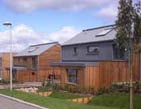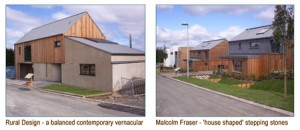 No-one’s denying that the recent opening of Scotland’s first Housing Expo near Inverness has been mired in chaos – least of all the backers, Highland Council and the Highland Housing Alliance, a group bringing together five local housing associations.
No-one’s denying that the recent opening of Scotland’s first Housing Expo near Inverness has been mired in chaos – least of all the backers, Highland Council and the Highland Housing Alliance, a group bringing together five local housing associations.
Credit crunched, frozen solid over the winter and working to a protean brief, the event has opened with most of the 50+ houses unfinished, some barely started and much of the site looking like a builders yard. It’s all fairly shambolic, too much of the workmanship is shoddy and the whole affair sits comfortably in the Scottish Construction Projects Hall of Fame : a junior partner to the Scottish Parliament and the Edinburgh Trams Project.
Having said all that, the positive side far outweighs the failings, many of which were beyond control. There are some well designed houses, slotting into Cadell2’s rightly ambitious master plan. Skye based Rural Design have placed a vernacular scottish highland cottage on top of a confident and contemporary larger structure, blessed with local materials and a welcoming layout. It’s an act of immaculate balance – which is just as well in the circumstances.
Malcolm Fraser’s detached and semis sit side by side, offering a neat frontage to the street, unpretentious detailing and a rare moment of unity on the Expo site. Above all, they’re ‘house’ shaped and offer a glimpse of how aspirants might slip from soulless volume builder coop to distinctive, dignified living in one easy step.
There are also some stinkers, but with the exception of Richard Murphy’s bannister detailing (which merits a special mention), let’s not dwell on those.
Neil Sutherland and myself co-presented a session at the Expo attended by numerous RIAS delegates. Johnny Cadell explained the master plan’s effort to create a distinct ‘place’, then some of the Expo architects described their houses. The two of us then moved on to the issue of how architecture might contribute more broadly to the kind of places and lifestyles we want to encourage.
What are these places and lifestyles? We already have a guide in the Scottish Government’s National Outcomes – a 15 point template for a more civilised, cultured and healthy society. These Outcomes inform Community Planning Partnerships in local authority areas, where public agencies (Council, health, police, fire etc) co-operate with SNH, SEPA and others on service provision. The Single Outcome Agreement arising from this process in turn informs the Development Plan.
This prodigious effort to focus local public sector activity on national aims is laudable. It does beg one question – what role does the private sector have in fulfilling broader objectives? Actually two questions – how many of us know or are even aware of our National Outcomes?
In seeking a more considered approach from the development industry in delivering architecture and places, we need to actively promote and apply the grander civic objectives which sit behind policy. Why shouldn’t we demand that private development contributes more directly to a more civilised society? The ‘right to develop’ took prominence in the Thatcher era, when ‘society’ was seen as the enemy of unbridled capitalism. Look where that got us.
Perched above the National Objectives, the Scottish Government’s over riding (and again entirely laudable) aim is to achieve sustainable economic growth. That’s subtly different to a ‘right to develop’. What we need is a right to develop the right kind of development.
The Housing Expo is a focus for this debate. What kind of houses can we build? Can we recapture local identity and understand the factors that are shaping our contemporary Scottish and regional vernacular? Can we reconnect architecture with people, place, culture and society? I don’t have all the answers and neither does the Expo. But in merely raising these questions, it achieves success. We should learn from the current experience and do it all again sometime soon.
“There are three classes of people: those who see; those who see when they are shown; those who do not see.” Leonardo Da Vinci (1452-1519).
Richard Heggie


